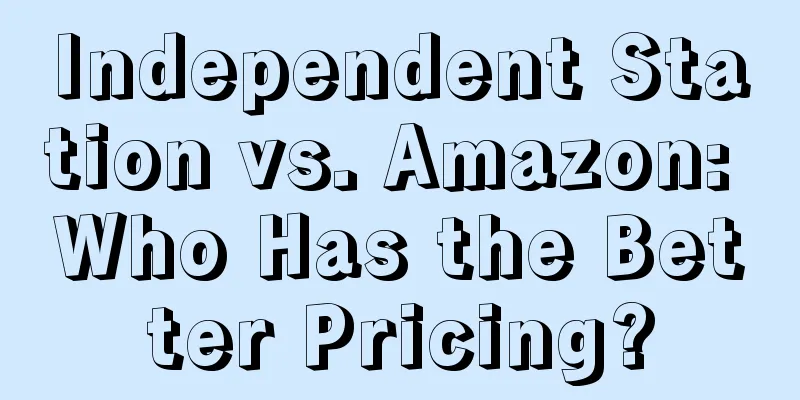Independent Station vs. Amazon: Who Has the Better Pricing?

|
In the vast cross-border e-commerce blue ocean, independent websites and Amazon are like two shining stars, guiding sellers to the other side of profits. On these two routes, pricing strategy has become the most difficult challenge for sellers. 01 Independent station pricing strategy 1 Competition-Based Pricing Competition-oriented pricing refers to a method in which companies pay close attention to competitors' prices, use competitors' prices as the main basis for pricing their own products, and increase or reduce prices based on competitors' prices. You must always keep a close eye on its prices. For example, if its price goes up, you can follow the increase in time. If its price goes down, you may also need to lower the price in time. This method is relatively simple. If you can find a good website of the same industry, you can refer to its prices and make a price increase or decrease. 2 Cost-Based Pricing It is mainly divided into two types: profit-oriented pricing and profit margin-oriented pricing. Profit-oriented: pricing is determined by calculating costs plus expected profits. Profit margin oriented: pricing is based on total cost plus a certain percentage of profit margin. 3 Demand-Based Pricing Market-oriented pricing is a method of determining prices based on consumers' perception of product value and the intensity of their demand, that is, consumers' values. Generally speaking, the more consumers recognize the value of a company's products, the higher the product's price will be; the higher the market demand for the product, the higher the product's price will be. 02 Amazon Pricing Strategy 1 Cost-plus pricing Similar to independent websites, Amazon sellers also add expected profits to their costs. However, due to the high fees on the Amazon platform, sellers need to consider the impact of platform fees on pricing. For example: If the cost of a product is $10 and the seller hopes to earn a 20% profit margin, the selling price will be set at $12. On Amazon, in addition to the product cost, sellers also need to consider the fees charged by Amazon, such as transaction fees, inventory storage fees, long-term storage fees, etc., which will affect the final pricing. 2 Amazon Suggested Pricing Amazon provides sellers with suggested selling prices based on the product’s historical sales data and market trends. These recommendations are designed to help sellers set competitive prices, thereby increasing sales and market share. For example, a seller selling smart watches on Amazon sets the cost at $50 and hopes to make a 30% profit, so the price is $70. Amazon's algorithm will analyze sales data, customer behavior, competitive pricing, and market trends. If sales are not good, the algorithm may recommend a price reduction to $65 to increase sales and competitiveness. 3 Amazon FBA Pricing Method Sellers who use the Fulfillment by Amazon (FBA) service can set higher prices because Amazon is responsible for the storage, packaging, shipping, and customer service of the products. However, sellers need to ensure that the prices are still competitive. For example: A toy costs $20. The seller wants to maintain a 30% profit margin, so without Amazon fees, the selling price is set at $26. When the seller chooses to use the FBA service, the total cost becomes $20 (product cost) + $0.40 (storage fee) + $2.00 (delivery fee) + $2.00 (handling fee) = $24.40. Therefore, the seller can adjust the selling price to $31, so that after deducting the FBA fee, the seller can still maintain a 30% profit margin. The new selling price is $31, the total cost is $24.40, and the profit is $6.60 03 Advantages of independent stations and Amazon pricing strategies 1 Advantages of independent station pricing strategy Less market competition: Independent station sellers can avoid direct competition with a large number of competitors and reduce price wars. High autonomy: Sellers can set prices independently based on market changes, competitor pricing and other factors, which is more conducive to brand building and market positioning. Brand image building: As the seller’s own e-commerce platform, the independent website can better display the brand image and enhance the brand value. On the independent website, sellers can independently design pages, display products, and publish brand stories, thereby enhancing consumers’ brand awareness. 2 Disadvantages of independent station pricing strategy User trust: Compared with large e-commerce platforms such as Amazon, independent websites may have certain disadvantages in terms of user trust. Therefore, sellers need to spend more energy on improving user experience and optimizing after-sales service. Large investment of resources: Brand building and marketing promotion require a lot of time and money to acquire target users. 3 Advantages of independent station pricing strategy Huge market share: Amazon is one of the world's largest online retailers, with a massive amount of user and sales data. This enables Amazon to understand consumer demand more accurately and price different products according to market demand. Support third-party sellers: Amazon can provide a platform for third-party sellers to sell products on Amazon and adopt corresponding pricing strategies. These sellers can handle product inventory, prices, marketing strategies, etc. through Amazon's pricing tools, enabling them to better control their products and sales. Convenient payment and logistics: Amazon provides one-stop payment and logistics services to simplify the transaction process and improve the user shopping experience. 4 Disadvantages of independent station pricing strategy · Fierce competition: Amazon is highly competitive, especially in popular categories. Sellers need to face many competitors and adopt effective differentiation strategies to stand out. Low pricing autonomy: Amazon has certain restrictions on sellers’ pricing. Sellers need to follow the platform rules, otherwise their product listings may be removed from the shelves. High platform fees: Sellers need to pay certain platform fees, which affect their profit margins, such as advertising fees, logistics fees, etc. The above are some pricing strategies of Amazon and independent websites. Each pricing strategy has its own advantages. Different pricing strategies can be selected at different stages. Sellers need to choose the most suitable pricing strategy according to their own product characteristics, market positioning and business goals. At the same time, pay attention to market trends and flexibly adjust prices to maximize profits. |
<<: The giant liquidates! A 3 billion seller announces its withdrawal from cross-border e-commerce
>>: A large number of sellers' stores have run into problems and are seeking redress...
Recommend
Walmart launches rewards program for Walmart+ members to compete with Amazon
<span data-docs-delta="[[20,"获悉,据外媒报道,近日沃尔...
What to do if Amazon automatic ads have zero exposure and zero clicks
What to do if Amazon automatic ads have zero expos...
One move to turn your competitor's link into a dog, the black technology of turning the link into a dog worth tens of thousands of yuan and the method of appeal!
In the cross-border industry, everyone makes money...
Canadian Tire plans to launch smart parcel lockers to improve delivery levels
<span data-shimo-docs="[[20,"获悉,据外媒报道,Cana...
Don’t know about off-site traffic yet? Here’s a guide to how to achieve off-site traffic
● Benefits outside the site ● ● Difficulties enco...
What is Campay? Campay Review
Campay provides email marketing solutions for smal...
Teach you how to quickly complete dangerous goods audit
Many sellers may encounter dangerous goods audits...
What is DS Amazon Quick View? DS Amazon Quick View Review
DS Amazon Quick View is a convenient and fast brow...
Amazon vice president resigns in disappointment, and French warehouses continue to be closed!
Today, Amazon's European sites have slowly res...
Smart home sales in the United States are growing strongly! What are consumers' purchasing motivations?
According to NPD data, sales of smart home product...
A detailed guide to handling one-star negative reviews on Amazon
Today's Share Amazon In-site Advertising Opti...
This summer, UPS may face the largest strike in history
It is learned that on June 16, the Washington Post...
Walmart launches new seller support program, waiving 25% sales commission!
Walmart is actively recruiting third-party sellers...
What is Ninja Outreach? Ninja Outreach Review
Ninja OutREACH is a social platform marketing anal...
What is Shopee store positioning? Shopee store positioning review
Shopee department store and boutique store positio...









